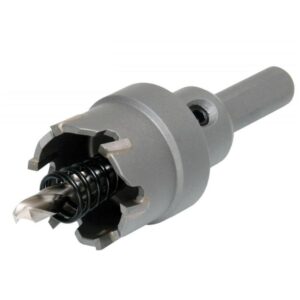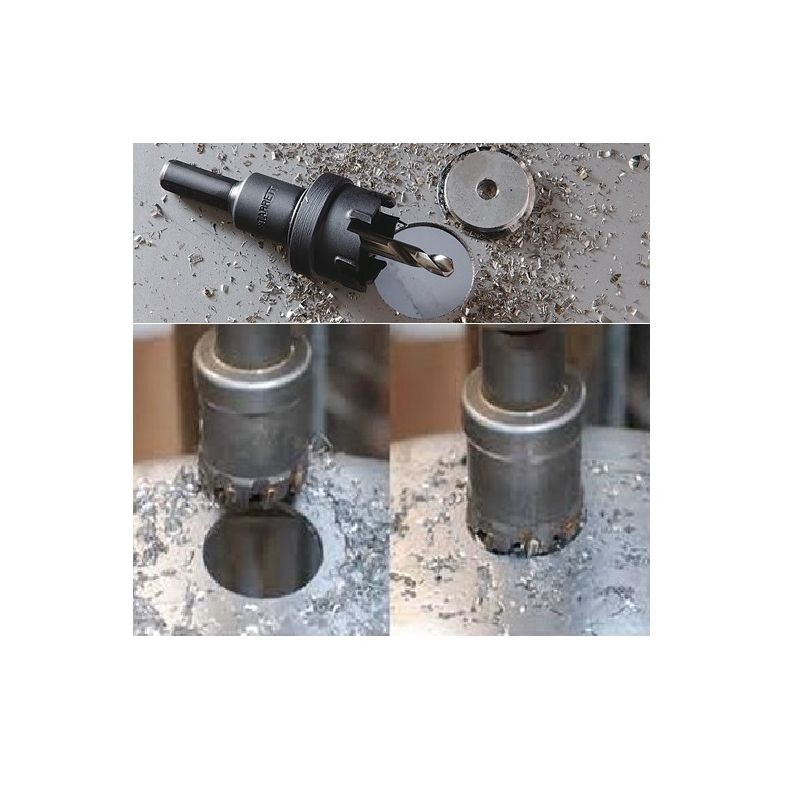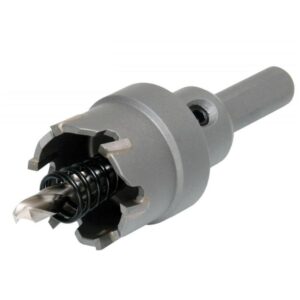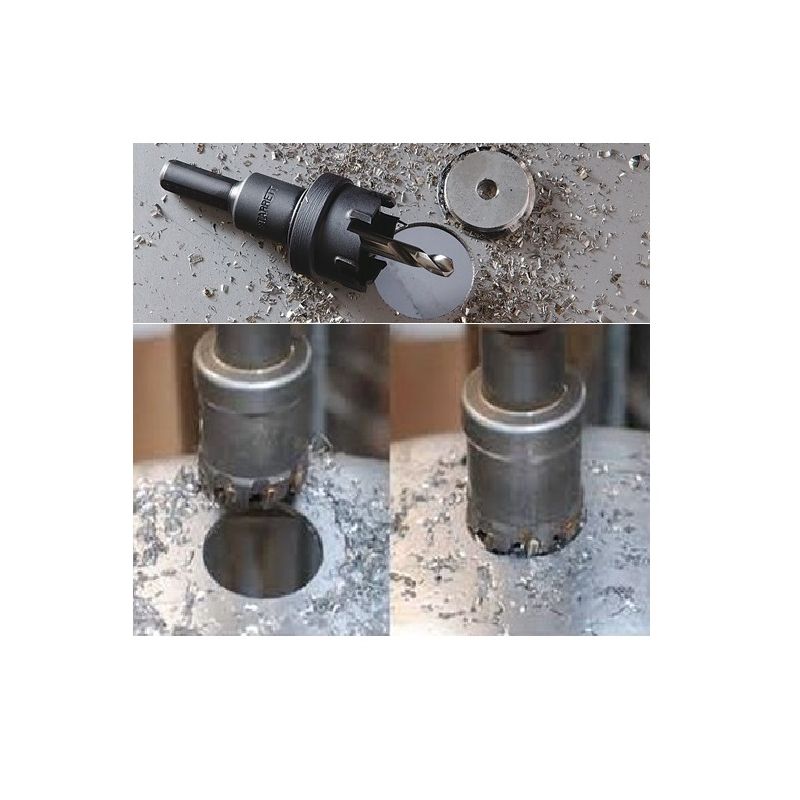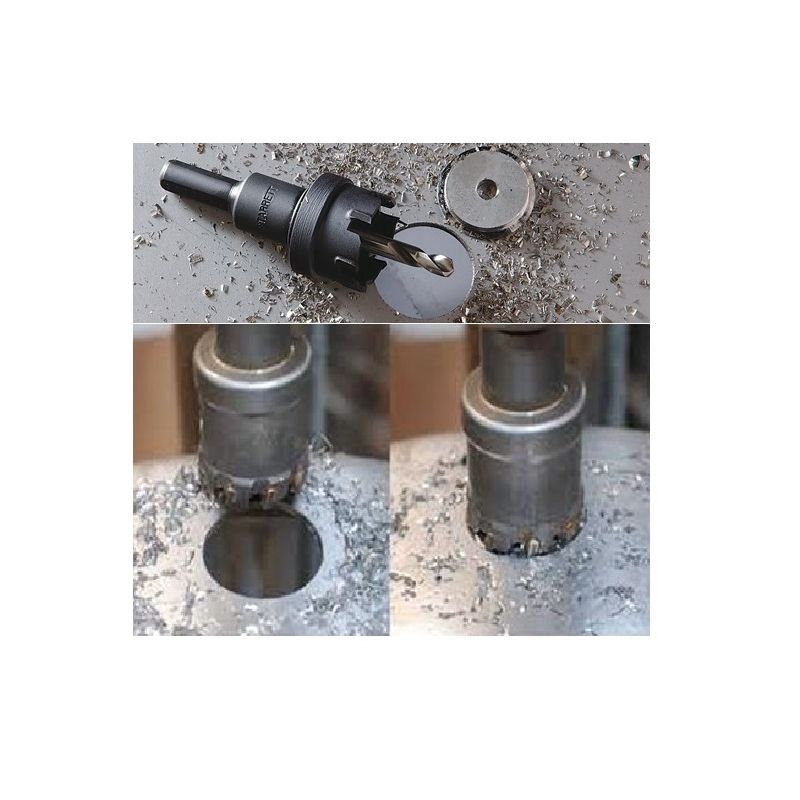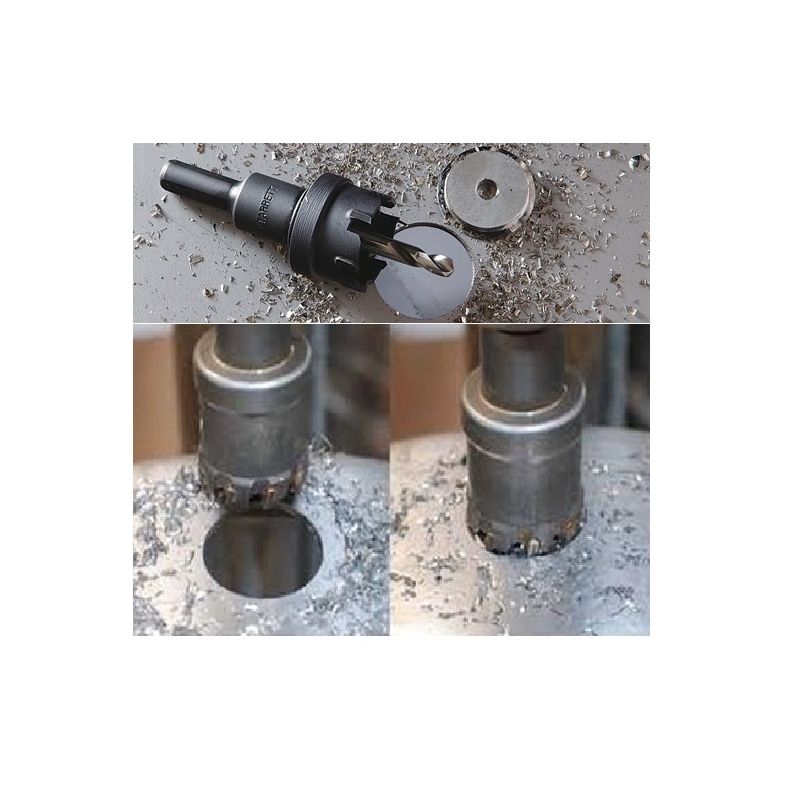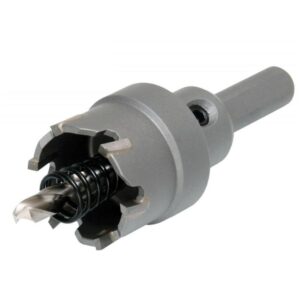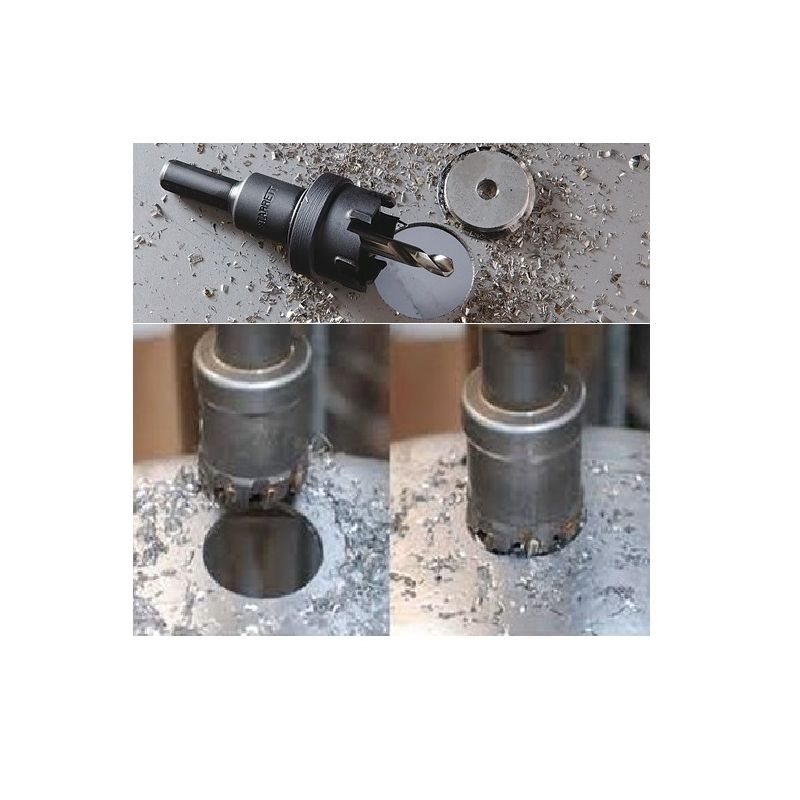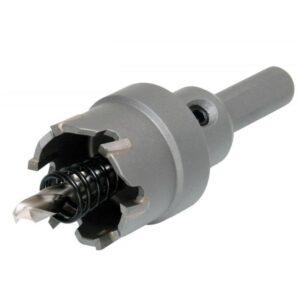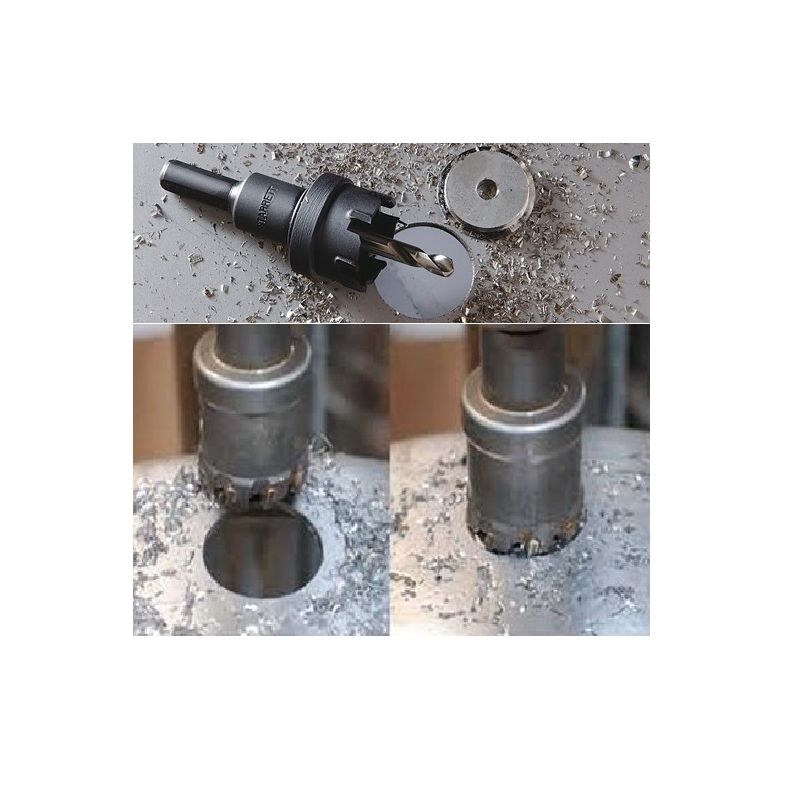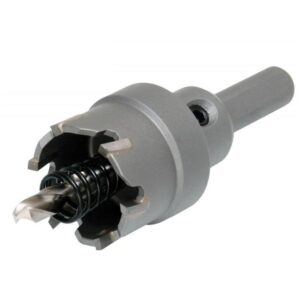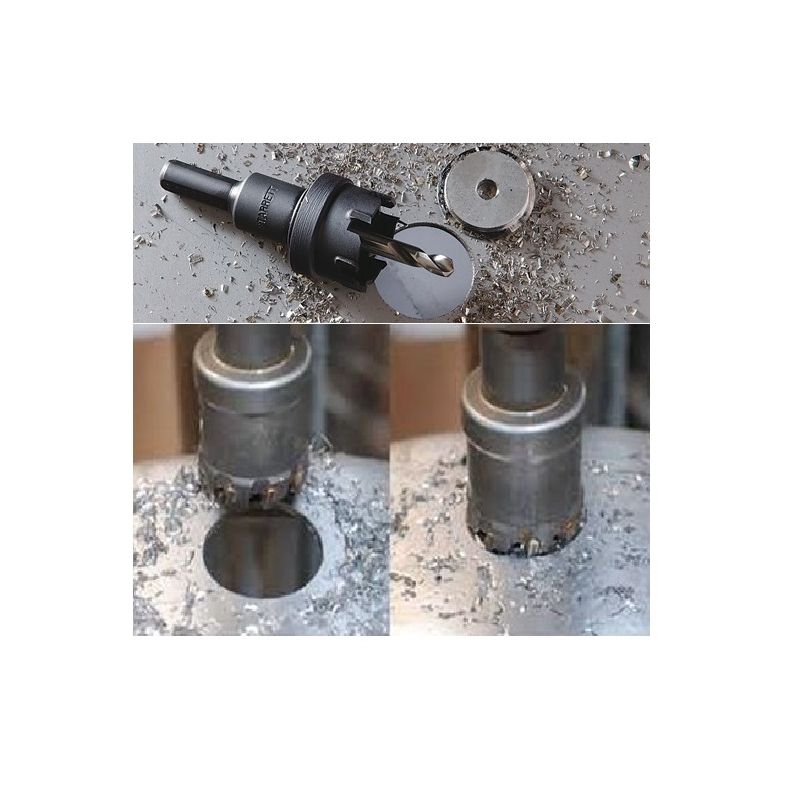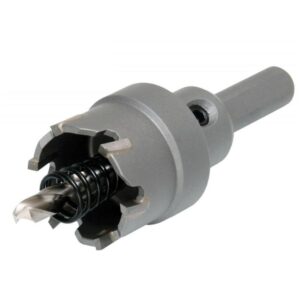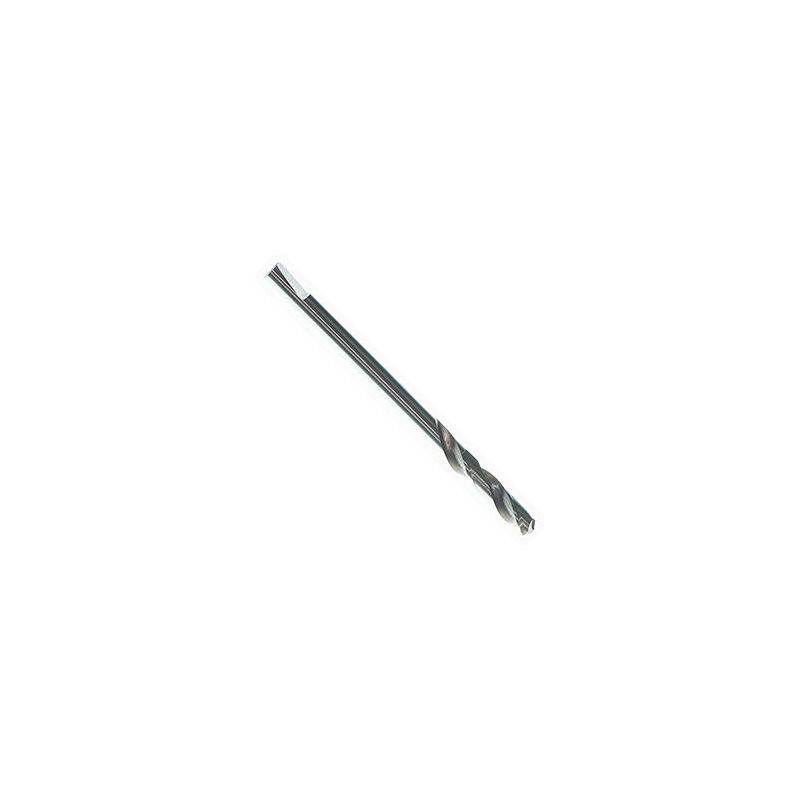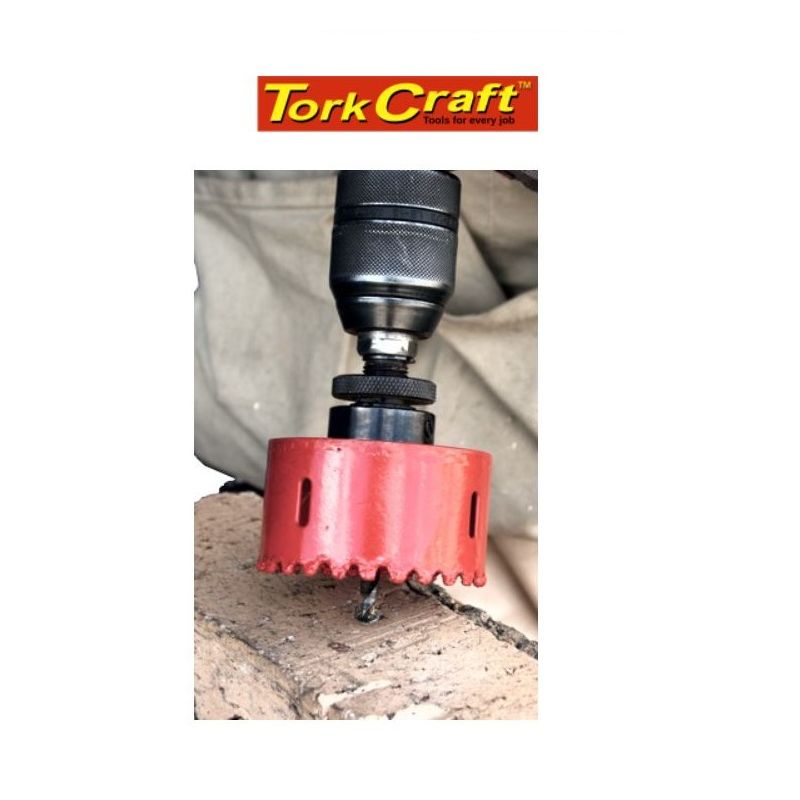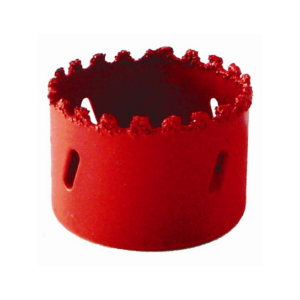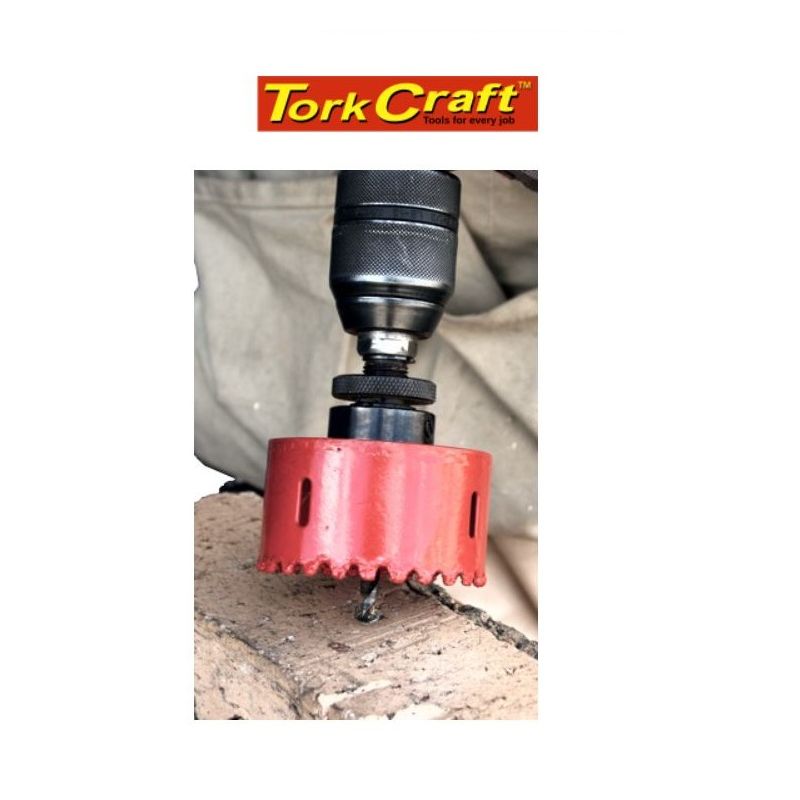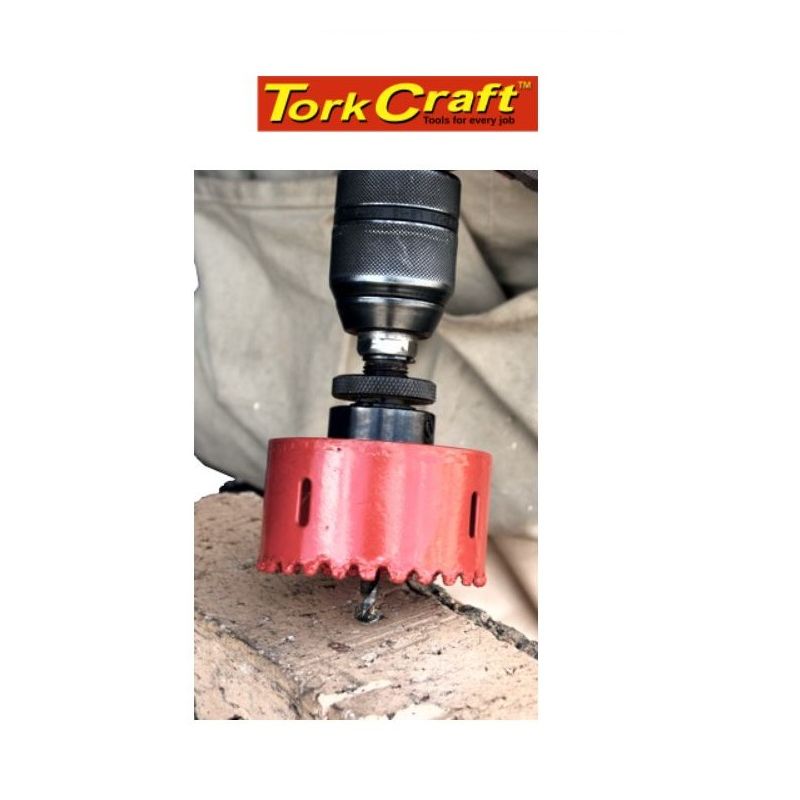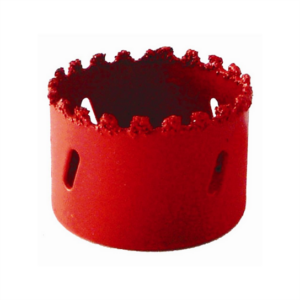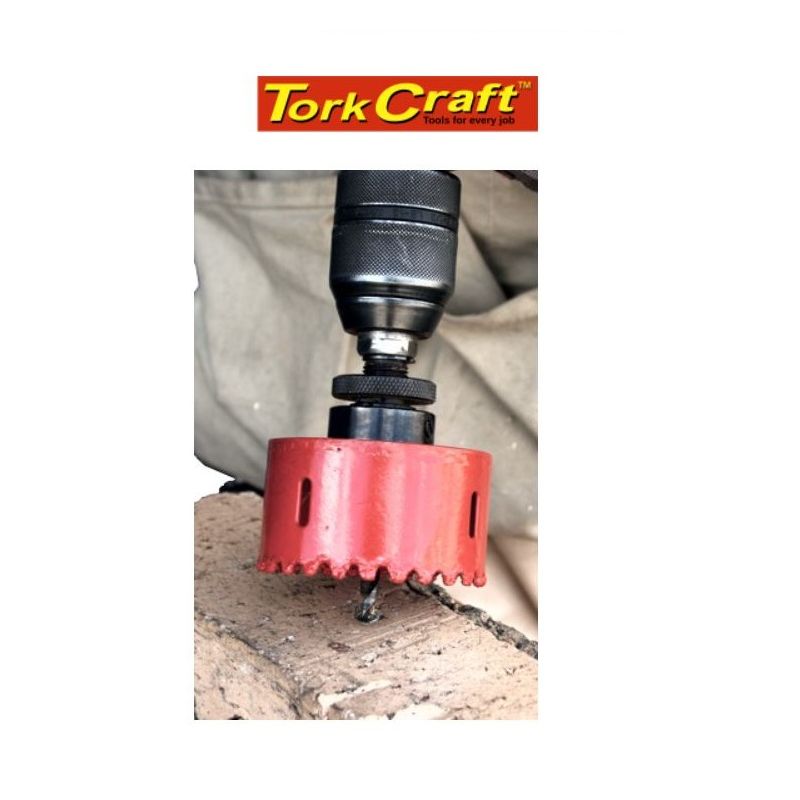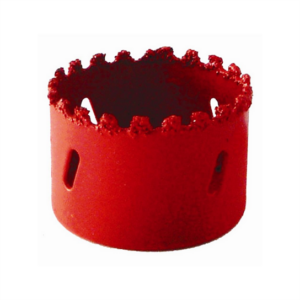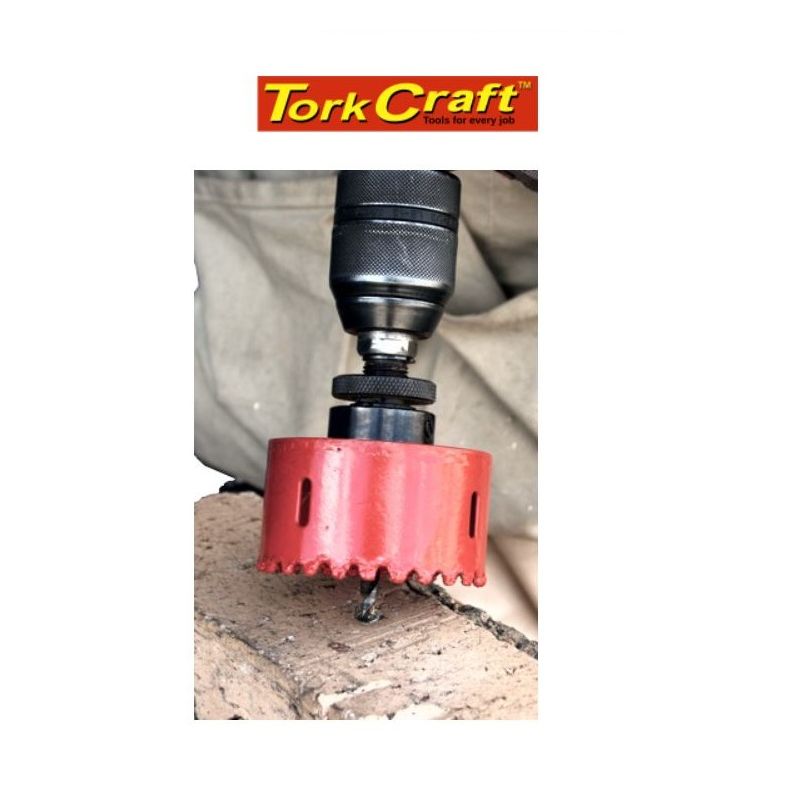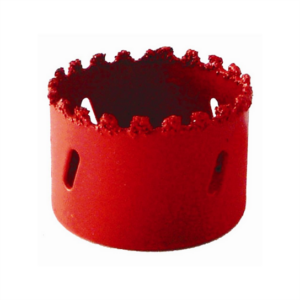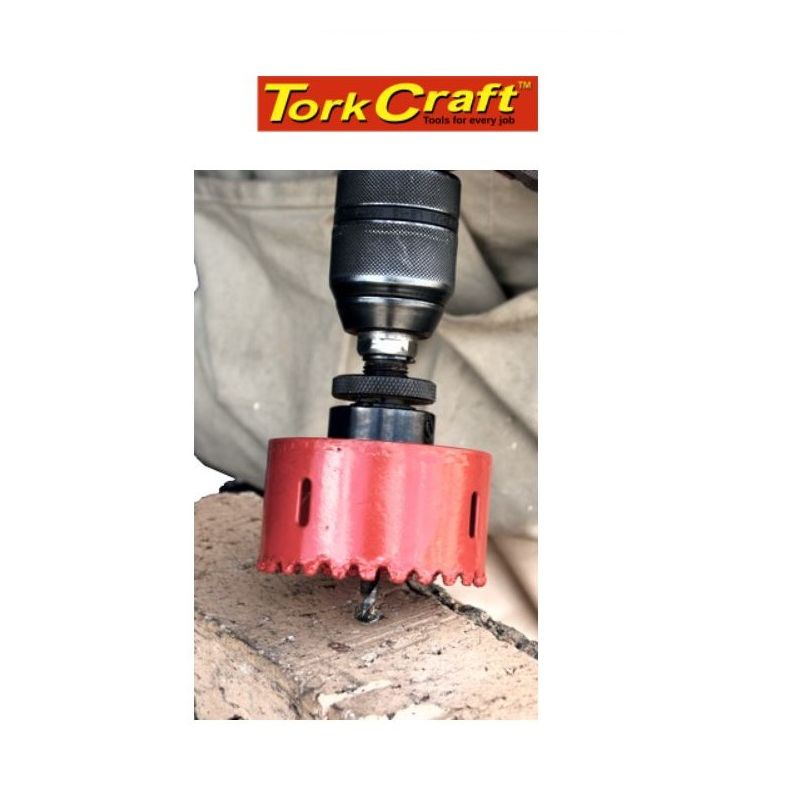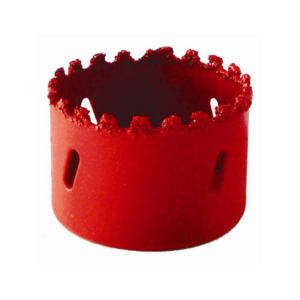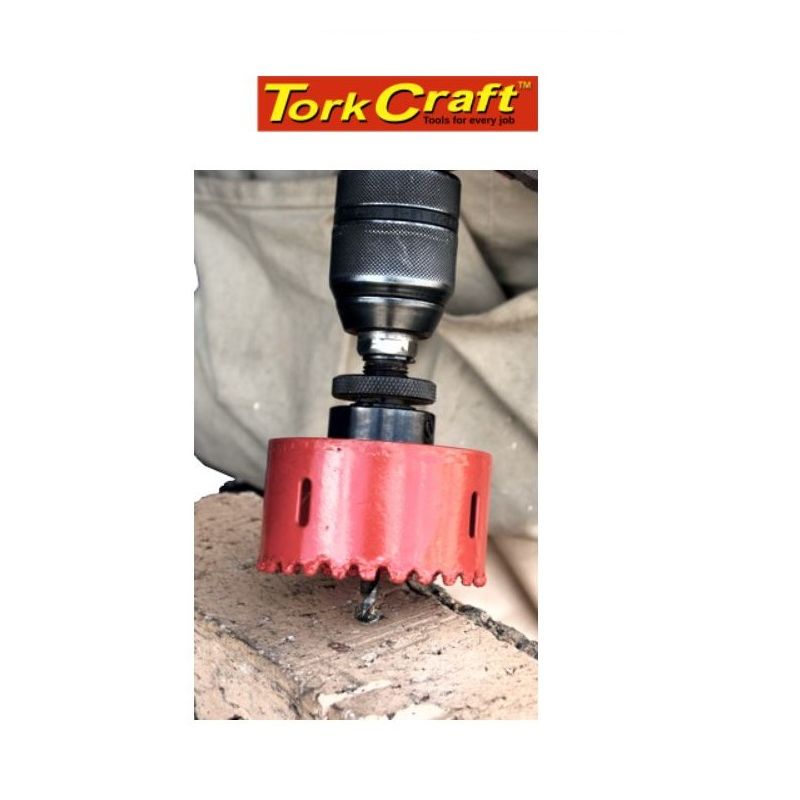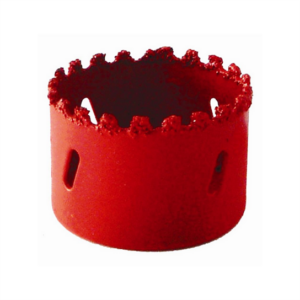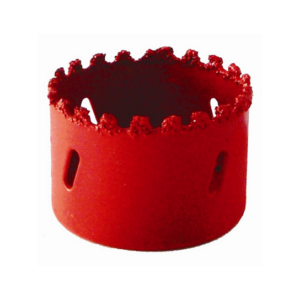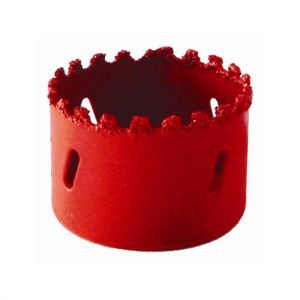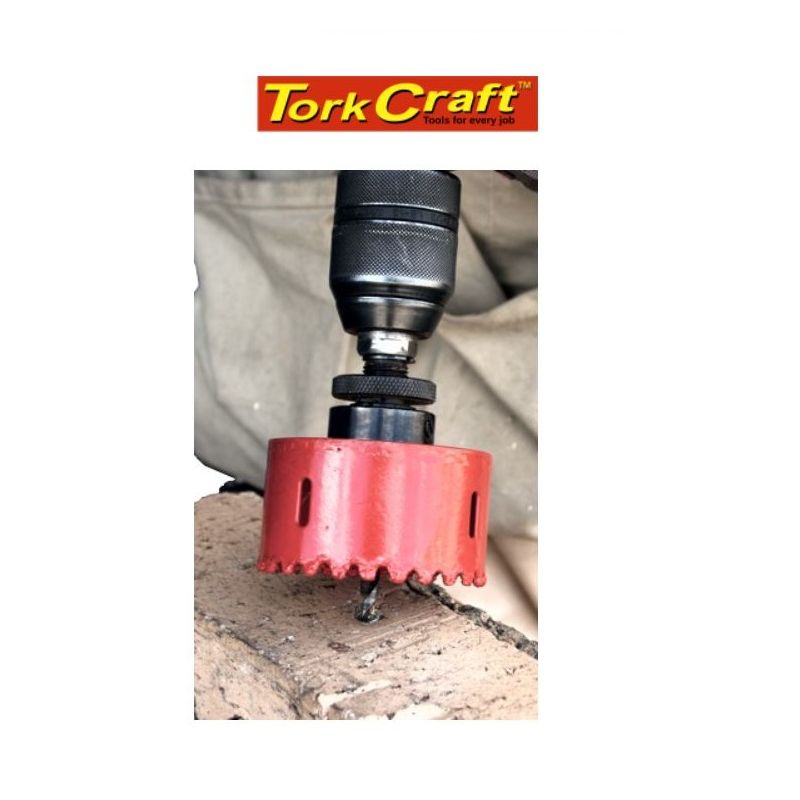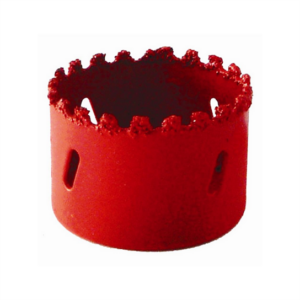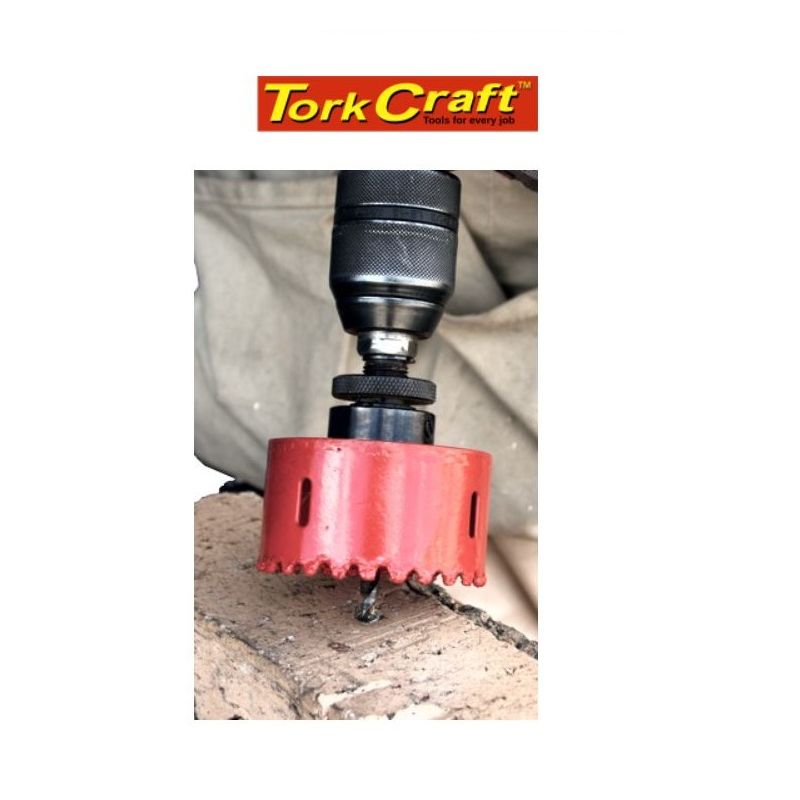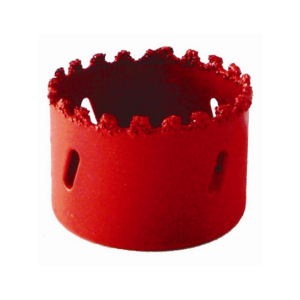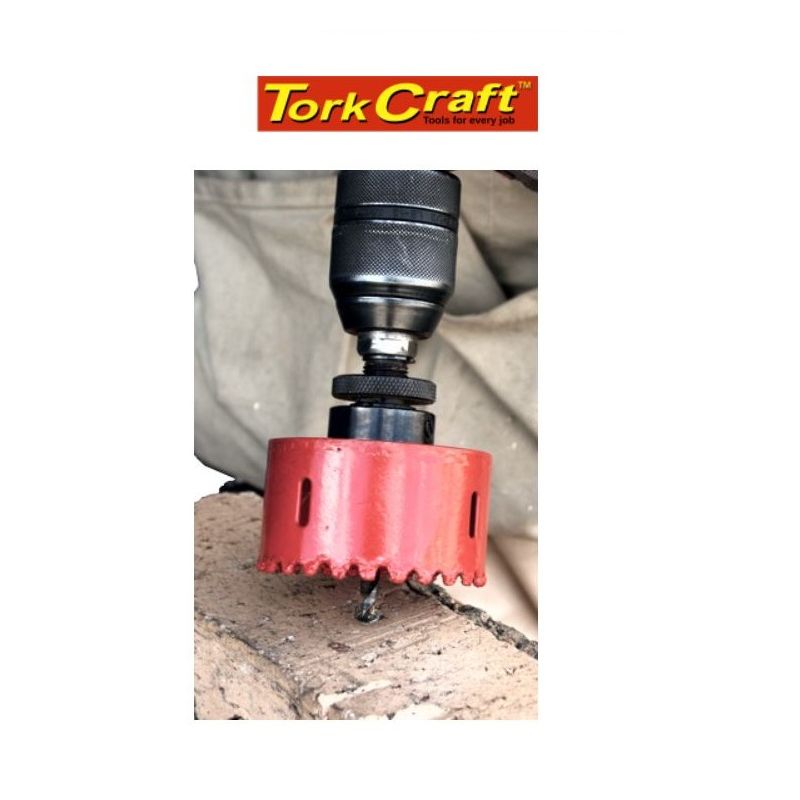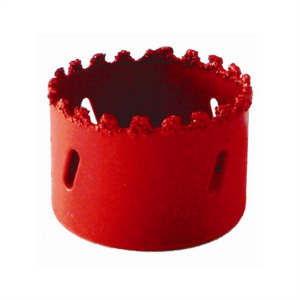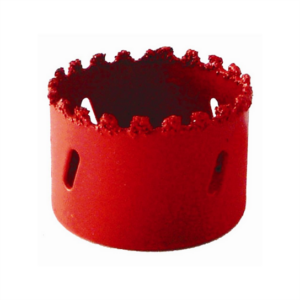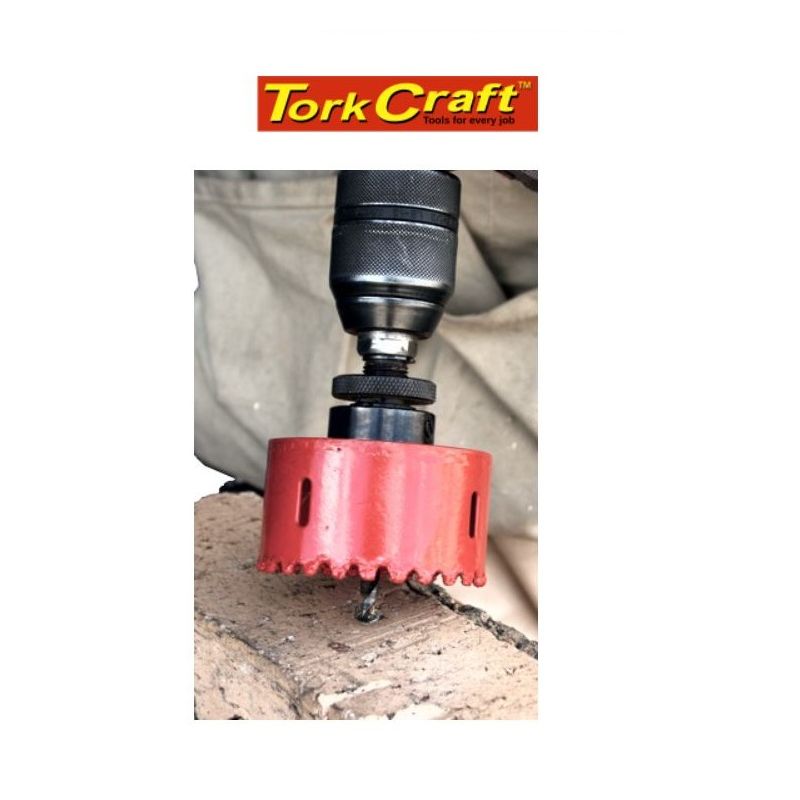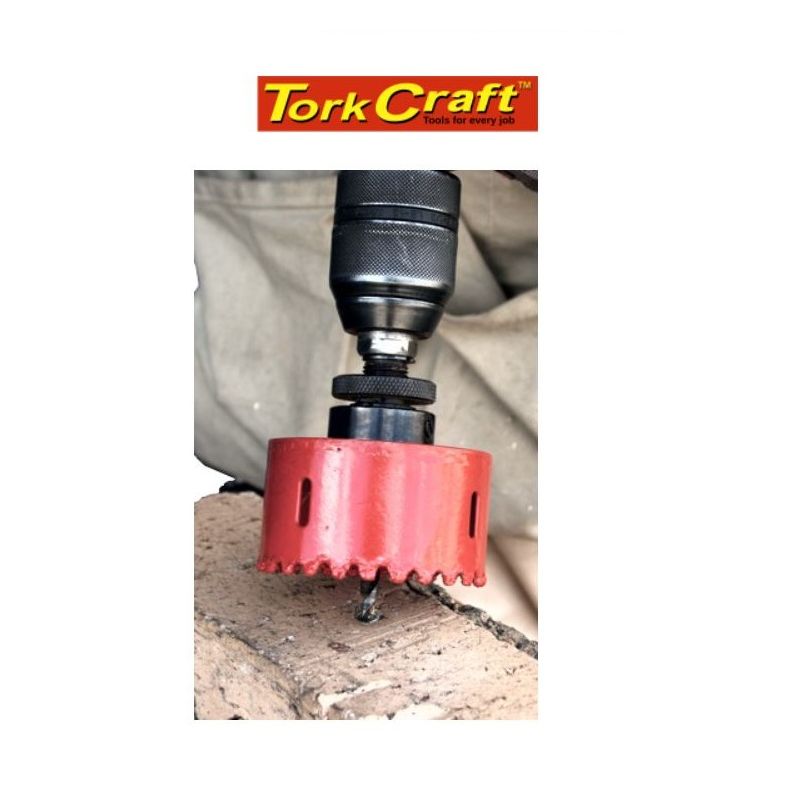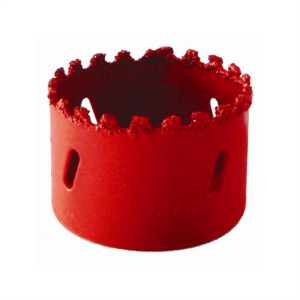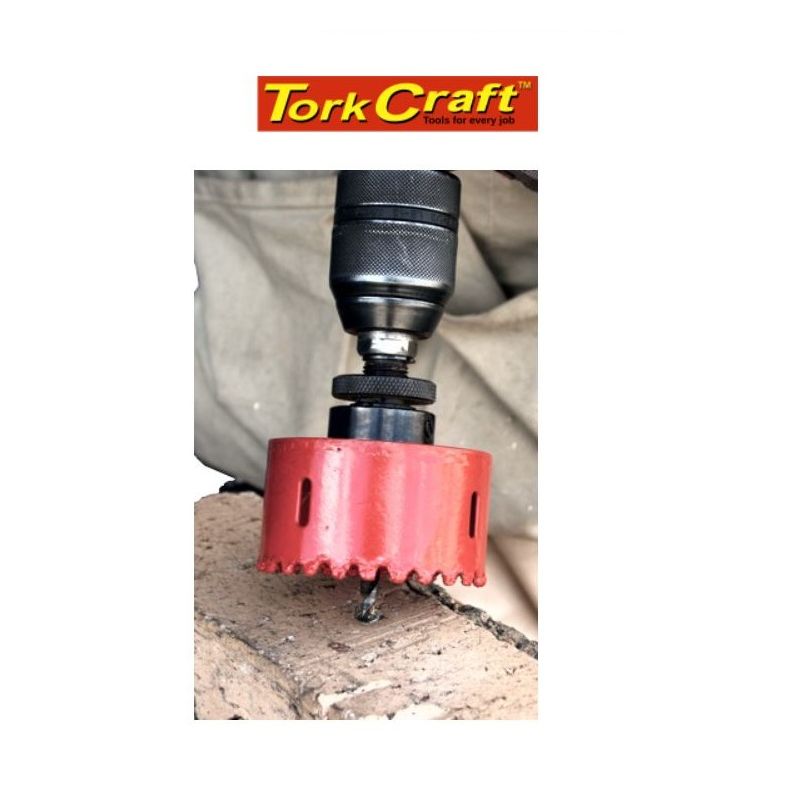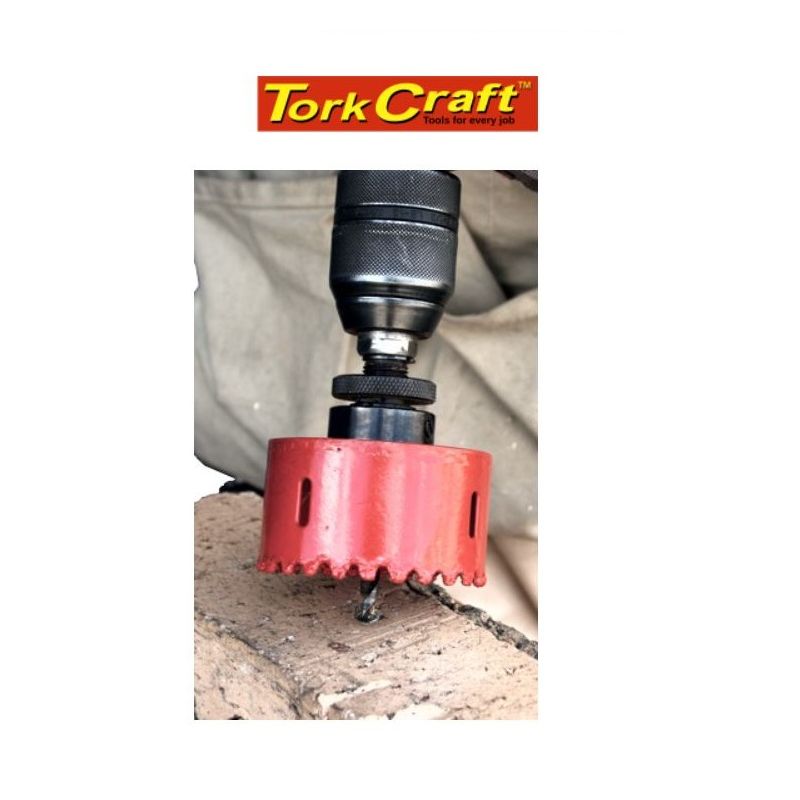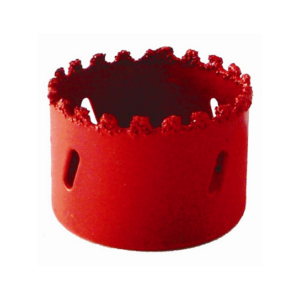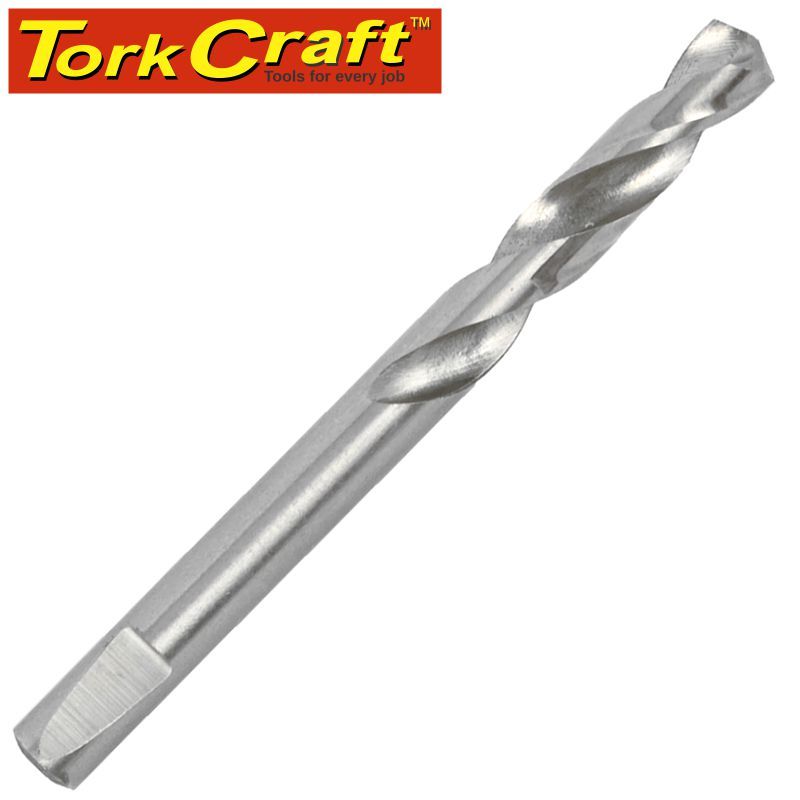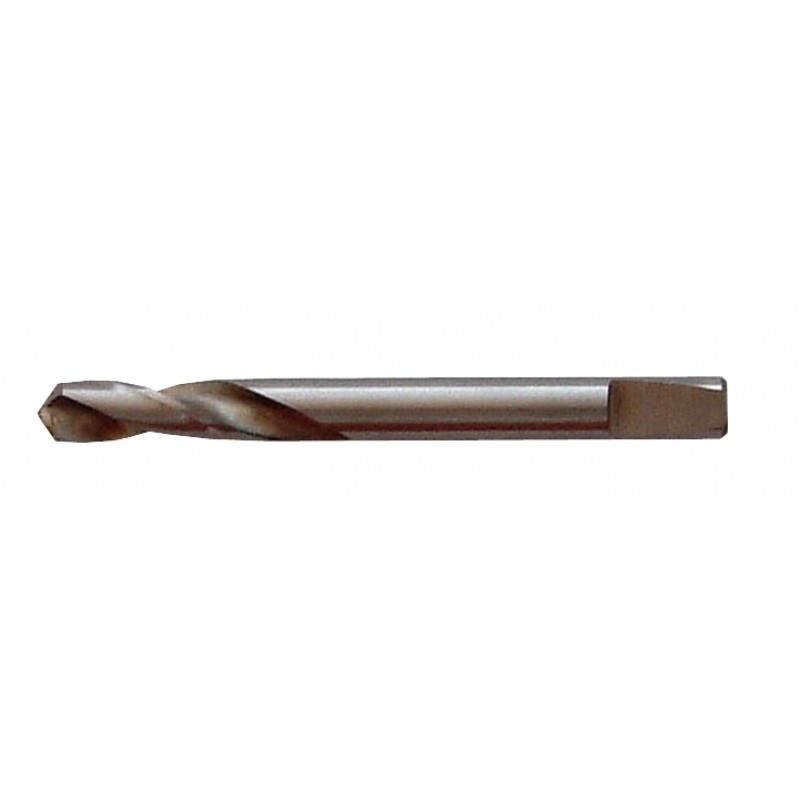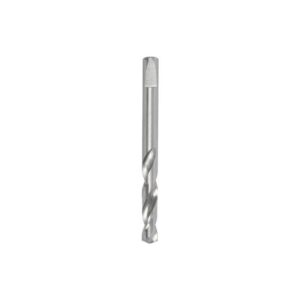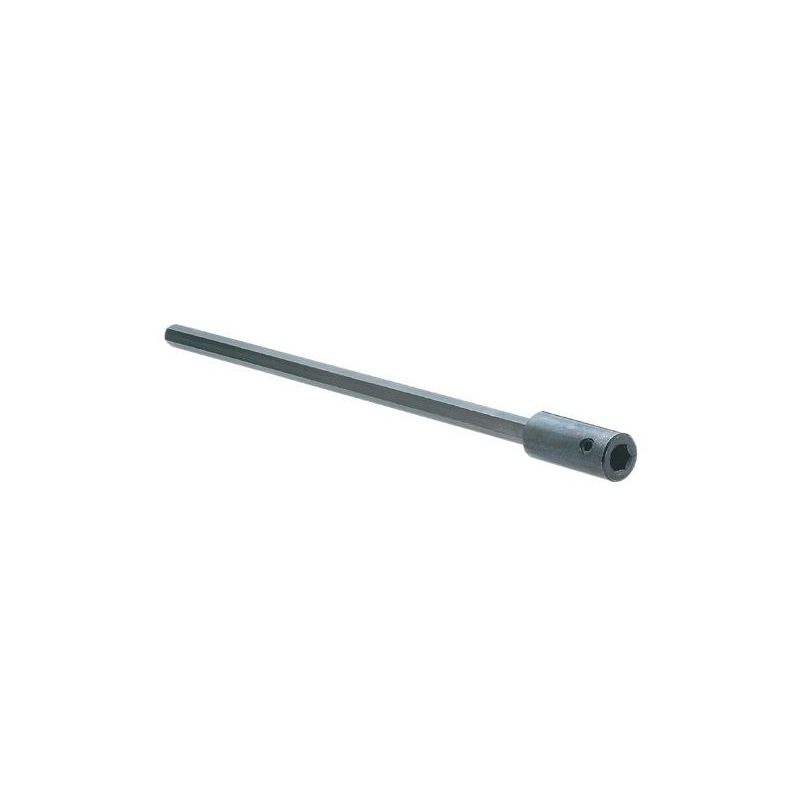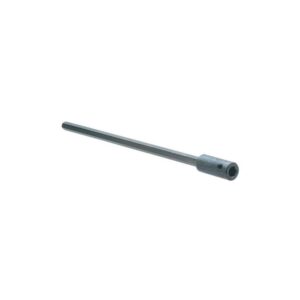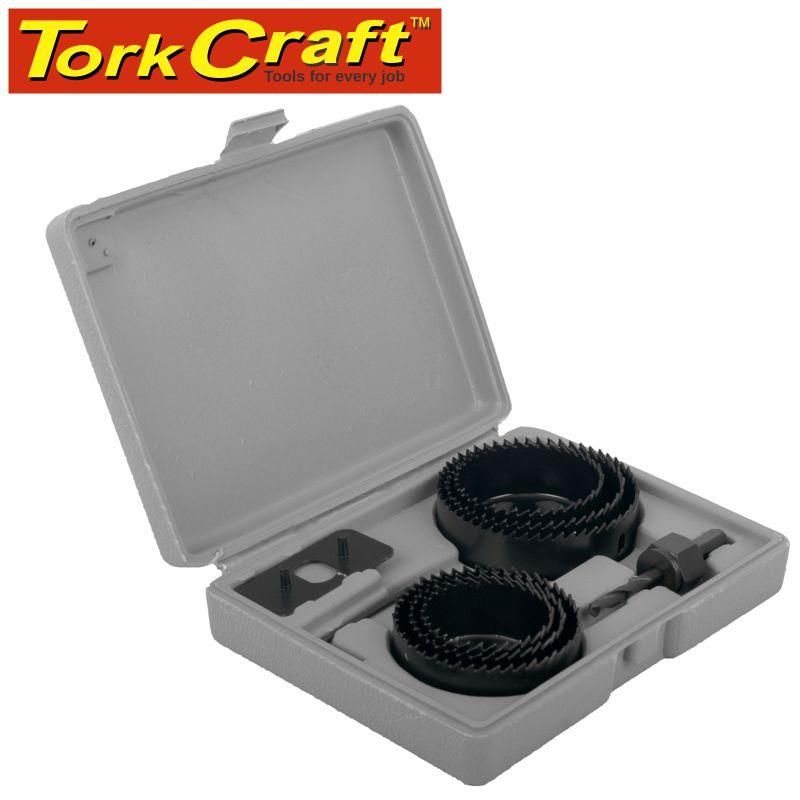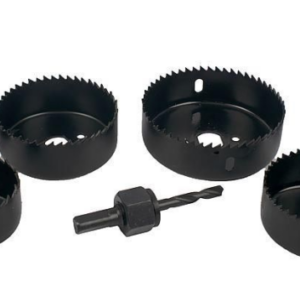Showing 321–352 of 779 results
-
Steel & Stainlessl Hole Saws
Hole Saw TCT Steel & Stainless – 055mm
Quick ViewR370,00Application:
The multiple precision ground Tungsten Carbide Tipped hole saw has been specially developed to cut holes in hard materials such as plastic and metals up to 4.5mm in thickness.
The hole saw can be used to cut into:
- Mild steel sheets
- Stainless steel sheets
- Steel pipes
- Cast iron
- Fiberglass
- Fibre-reinforced plastic (FRP)
- Aluminium
- Brass
- Vinyl
- Plastic
IMPORTANT: For the best results and for safety reasons, use the recommended rotation speed for the material being drilled into.
Lubricant tip: Use paraffin or beeswax when cutting into aluminium. Use CT-90 or a general-purpose lubricating oil when cutting into steel.
Using a hole saw:
To use a hole saw, you need the following accessories:
- A portable drill or stationary drill with a 3 jaw chuck.
- The necessary safety equipment. Safety goggles, gloves and hearing protection.
For longer hole saw life, use the following instructions:
- Use the correct rotation speed. If the speed is too high or too low, it will have an effect on the cutting edge on the hole saw and decrease the life expectancy.
- Clear away metal filings frequently to prevent the hole saw from overheating.
- Always apply the necessary pressure for the intended use. Too much pressure can destroy the teeth when cutting in metals.
- Keep the drill going straight to avoid binding the hole saw.
-
Steel & Stainlessl Hole Saws
Hole Saw TCT Steel & Stainless – 060mm
Quick ViewR410,00Application:
The multiple precision ground Tungsten Carbide Tipped hole saw has been specially developed to cut holes in hard materials such as plastic and metals up to 4.5mm in thickness.
The hole saw can be used to cut into:
- Mild steel sheets
- Stainless steel sheets
- Steel pipes
- Cast iron
- Fiberglass
- Fibre-reinforced plastic (FRP)
- Aluminium
- Brass
- Vinyl
- Plastic
IMPORTANT: For the best results and for safety reasons, use the recommended rotation speed for the material being drilled into.
Lubricant tip: Use paraffin or beeswax when cutting into aluminium. Use CT-90 or a general-purpose lubricating oil when cutting into steel.
Using a hole saw:
To use a hole saw, you need the following accessories:
- A portable drill or stationary drill with a 3 jaw chuck.
- The necessary safety equipment. Safety goggles, gloves and hearing protection.
For longer hole saw life, use the following instructions:
- Use the correct rotation speed. If the speed is too high or too low, it will have an effect on the cutting edge on the hole saw and decrease the life expectancy.
- Clear away metal filings frequently to prevent the hole saw from overheating.
- Always apply the necessary pressure for the intended use. Too much pressure can destroy the teeth when cutting in metals.
- Keep the drill going straight to avoid binding the hole saw.
-
Steel & Stainlessl Hole Saws
Hole Saw TCT Steel & Stainless – 065mm
Quick ViewR430,00Application:
The multiple precision ground Tungsten Carbide Tipped hole saw has been specially developed to cut holes in hard materials such as plastic and metals up to 4.5mm in thickness.
The hole saw can be used to cut into:
- Mild steel sheets
- Stainless steel sheets
- Steel pipes
- Cast iron
- Fiberglass
- Fibre-reinforced plastic (FRP)
- Aluminium
- Brass
- Vinyl
- Plastic
IMPORTANT: For the best results and for safety reasons, use the recommended rotation speed for the material being drilled into.
Lubricant tip: Use paraffin or beeswax when cutting into aluminium. Use CT-90 or a general-purpose lubricating oil when cutting into steel.
Using a hole saw:
To use a hole saw, you need the following accessories:
- A portable drill or stationary drill with a 3 jaw chuck.
- The necessary safety equipment. Safety goggles, gloves and hearing protection.
For longer hole saw life, use the following instructions:
- Use the correct rotation speed. If the speed is too high or too low, it will have an effect on the cutting edge on the hole saw and decrease the life expectancy.
- Clear away metal filings frequently to prevent the hole saw from overheating.
- Always apply the necessary pressure for the intended use. Too much pressure can destroy the teeth when cutting in metals.
- Keep the drill going straight to avoid binding the hole saw.
-
Steel & Stainlessl Hole Saws
Hole Saw TCT Steel & Stainless – 070mm
Quick ViewR460,00Application:
The multiple precision ground Tungsten Carbide Tipped hole saw has been specially developed to cut holes in hard materials such as plastic and metals up to 4.5mm in thickness.
The hole saw can be used to cut into:
- Mild steel sheets
- Stainless steel sheets
- Steel pipes
- Cast iron
- Fiberglass
- Fibre-reinforced plastic (FRP)
- Aluminium
- Brass
- Vinyl
- Plastic
IMPORTANT: For the best results and for safety reasons, use the recommended rotation speed for the material being drilled into.
Lubricant tip: Use paraffin or beeswax when cutting into aluminium. Use CT-90 or a general-purpose lubricating oil when cutting into steel.
Using a hole saw:
To use a hole saw, you need the following accessories:
- A portable drill or stationary drill with a 3 jaw chuck.
- The necessary safety equipment. Safety goggles, gloves and hearing protection.
For longer hole saw life, use the following instructions:
- Use the correct rotation speed. If the speed is too high or too low, it will have an effect on the cutting edge on the hole saw and decrease the life expectancy.
- Clear away metal filings frequently to prevent the hole saw from overheating.
- Always apply the necessary pressure for the intended use. Too much pressure can destroy the teeth when cutting in metals.
- Keep the drill going straight to avoid binding the hole saw.
-
Steel & Stainlessl Hole Saws
Hole Saw TCT Steel & Stainless – 075mm
Quick ViewR480,00Application:
The multiple precision ground Tungsten Carbide Tipped hole saw has been specially developed to cut holes in hard materials such as plastic and metals up to 4.5mm in thickness.
The hole saw can be used to cut into:
- Mild steel sheets
- Stainless steel sheets
- Steel pipes
- Cast iron
- Fiberglass
- Fibre-reinforced plastic (FRP)
- Aluminium
- Brass
- Vinyl
- Plastic
IMPORTANT: For the best results and for safety reasons, use the recommended rotation speed for the material being drilled into.
Lubricant tip: Use paraffin or beeswax when cutting into aluminium. Use CT-90 or a general-purpose lubricating oil when cutting into steel.
Using a hole saw:
To use a hole saw, you need the following accessories:
- A portable drill or stationary drill with a 3 jaw chuck.
- The necessary safety equipment. Safety goggles, gloves and hearing protection.
For longer hole saw life, use the following instructions:
- Use the correct rotation speed. If the speed is too high or too low, it will have an effect on the cutting edge on the hole saw and decrease the life expectancy.
- Clear away metal filings frequently to prevent the hole saw from overheating.
- Always apply the necessary pressure for the intended use. Too much pressure can destroy the teeth when cutting in metals.
- Keep the drill going straight to avoid binding the hole saw.
-
Steel & Stainlessl Hole Saws
Hole Saw TCT Steel & Stainless – 080mm
Quick ViewR470,00Application:
The multiple precision ground Tungsten Carbide Tipped hole saw has been specially developed to cut holes in hard materials such as plastic and metals up to 4.5mm in thickness.
The hole saw can be used to cut into:
- Mild steel sheets
- Stainless steel sheets
- Steel pipes
- Cast iron
- Fiberglass
- Fibre-reinforced plastic (FRP)
- Aluminium
- Brass
- Vinyl
- Plastic
IMPORTANT: For the best results and for safety reasons, use the recommended rotation speed for the material being drilled into.
Lubricant tip: Use paraffin or beeswax when cutting into aluminium. Use CT-90 or a general-purpose lubricating oil when cutting into steel.
Using a hole saw:
To use a hole saw, you need the following accessories:
- A portable drill or stationary drill with a 3 jaw chuck.
- The necessary safety equipment. Safety goggles, gloves and hearing protection.
For longer hole saw life, use the following instructions:
- Use the correct rotation speed. If the speed is too high or too low, it will have an effect on the cutting edge on the hole saw and decrease the life expectancy.
- Clear away metal filings frequently to prevent the hole saw from overheating.
- Always apply the necessary pressure for the intended use. Too much pressure can destroy the teeth when cutting in metals.
- Keep the drill going straight to avoid binding the hole saw.
-
Steel & Stainlessl Hole Saws
Hole Saw TCT Steel & Stainless – 090mm
Quick ViewR640,00Application:
The multiple precision ground Tungsten Carbide Tipped hole saw has been specially developed to cut holes in hard materials such as plastic and metals up to 4.5mm in thickness.
The hole saw can be used to cut into:
- Mild steel sheets
- Stainless steel sheets
- Steel pipes
- Cast iron
- Fiberglass
- Fibre-reinforced plastic (FRP)
- Aluminium
- Brass
- Vinyl
- Plastic
IMPORTANT: For the best results and for safety reasons, use the recommended rotation speed for the material being drilled into.
Lubricant tip: Use paraffin or beeswax when cutting into aluminium. Use CT-90 or a general-purpose lubricating oil when cutting into steel.
Using a hole saw:
To use a hole saw, you need the following accessories:
- A portable drill or stationary drill with a 3 jaw chuck.
- The necessary safety equipment. Safety goggles, gloves and hearing protection.
For longer hole saw life, use the following instructions:
- Use the correct rotation speed. If the speed is too high or too low, it will have an effect on the cutting edge on the hole saw and decrease the life expectancy.
- Clear away metal filings frequently to prevent the hole saw from overheating.
- Always apply the necessary pressure for the intended use. Too much pressure can destroy the teeth when cutting in metals.
- Keep the drill going straight to avoid binding the hole saw.
-
Steel & Stainlessl Hole Saws
Hole Saw TCT Steel & Stainless – 100mm
Quick ViewR710,00Application:
The multiple precision ground Tungsten Carbide Tipped hole saw has been specially developed to cut holes in hard materials such as plastic and metals up to 4.5mm in thickness.
The hole saw can be used to cut into:
- Mild steel sheets
- Stainless steel sheets
- Steel pipes
- Cast iron
- Fiberglass
- Fibre-reinforced plastic (FRP)
- Aluminium
- Brass
- Vinyl
- Plastic
IMPORTANT: For the best results and for safety reasons, use the recommended rotation speed for the material being drilled into.
Lubricant tip: Use paraffin or beeswax when cutting into aluminium. Use CT-90 or a general-purpose lubricating oil when cutting into steel.
Using a hole saw:
To use a hole saw, you need the following accessories:
- A portable drill or stationary drill with a 3 jaw chuck.
- The necessary safety equipment. Safety goggles, gloves and hearing protection.
For longer hole saw life, use the following instructions:
- Use the correct rotation speed. If the speed is too high or too low, it will have an effect on the cutting edge on the hole saw and decrease the life expectancy.
- Clear away metal filings frequently to prevent the hole saw from overheating.
- Always apply the necessary pressure for the intended use. Too much pressure can destroy the teeth when cutting in metals.
- Keep the drill going straight to avoid binding the hole saw.
-
Hole Saws
Hole Saw TCT Steel & Stainless – Drill
Quick ViewR35,00Hole Saw TCT Steel & Stainless - Drill -
Congcrete / Tugston Hole Saws
Hole Saw Tungston Gritt, 016 – RED
Quick ViewR115,00-
Application:
- The hole saw's cup design is manufactured from a special alloy steel and the cutting edges are Tungsten Carbide gritted. It is specially designed to drill into abrasive materials.
- The hole saw can be used to cut into:
- Fiberglass
- Kevlar
- Asbestos
- Graphite
- Carbon
- Brick
- Tiles
- Plaster slabs
- Walls
- Light stones
- Weatherboard
-
Why use Carbide?
On the Mohs hardness scale, Tungsten Carbide is rated between 9 and 10. It is almost as hard as Diamond. The hole saw remains sharper for longer and it can be used to cut into many more materials.
-
Features:
- Strong design with a tough alloy body for added durability.
- Knock out holes for plug removal.
- Depth of cut: 38mm
- Carbide metal surface doesn't break off.
- Fast, aggressive cut in many materials with little effort
-
-
Congcrete / Tugston Hole Saws
Hole Saw Tungston Gritt, 019 – RED
Quick ViewR120,00-
Application:
- The hole saw's cup design is manufactured from a special alloy steel and the cutting edges are Tungsten Carbide gritted. It is specially designed to drill into abrasive materials.
- The hole saw can be used to cut into:
- Fiberglass
- Kevlar
- Asbestos
- Graphite
- Carbon
- Brick
- Tiles
- Plaster slabs
- Walls
- Light stones
- Weatherboard
-
Why use Carbide?
On the Mohs hardness scale, Tungsten Carbide is rated between 9 and 10. It is almost as hard as Diamond. The hole saw remains sharper for longer and it can be used to cut into many more materials.
-
Features:
- Strong design with a tough alloy body for added durability.
- Knock out holes for plug removal.
- Depth of cut: 38mm
- Carbide metal surface doesn't break off.
- Fast, aggressive cut in many materials with little effort
-
-
Congcrete / Tugston Hole Saws
Hole Saw Tungston Gritt, 020 – RED
Quick ViewR130,00-
Application:
- The hole saw's cup design is manufactured from a special alloy steel and the cutting edges are Tungsten Carbide gritted. It is specially designed to drill into abrasive materials.
- The hole saw can be used to cut into:
- Fiberglass
- Kevlar
- Asbestos
- Graphite
- Carbon
- Brick
- Tiles
- Plaster slabs
- Walls
- Light stones
- Weatherboard
-
Why use Carbide?
On the Mohs hardness scale, Tungsten Carbide is rated between 9 and 10. It is almost as hard as Diamond. The hole saw remains sharper for longer and it can be used to cut into many more materials.
-
Features:
- Strong design with a tough alloy body for added durability.
- Knock out holes for plug removal.
- Depth of cut: 38mm
- Carbide metal surface doesn't break off.
- Fast, aggressive cut in many materials with little effort
-
-
Congcrete / Tugston Hole Saws
Hole Saw Tungston Gritt, 022 – RED
Quick ViewR145,00-
Application:
- The hole saw's cup design is manufactured from a special alloy steel and the cutting edges are Tungsten Carbide gritted. It is specially designed to drill into abrasive materials.
- The hole saw can be used to cut into:
- Fiberglass
- Kevlar
- Asbestos
- Graphite
- Carbon
- Brick
- Tiles
- Plaster slabs
- Walls
- Light stones
- Weatherboard
-
Why use Carbide?
On the Mohs hardness scale, Tungsten Carbide is rated between 9 and 10. It is almost as hard as Diamond. The hole saw remains sharper for longer and it can be used to cut into many more materials.
-
Features:
- Strong design with a tough alloy body for added durability.
- Knock out holes for plug removal.
- Depth of cut: 38mm
- Carbide metal surface doesn't break off.
- Fast, aggressive cut in many materials with little effort
-
-
Congcrete / Tugston Hole Saws
Hole Saw Tungston Gritt, 025 – RED
Quick ViewR155,00-
Application:
- The hole saw's cup design is manufactured from a special alloy steel and the cutting edges are Tungsten Carbide gritted. It is specially designed to drill into abrasive materials.
- The hole saw can be used to cut into:
- Fiberglass
- Kevlar
- Asbestos
- Graphite
- Carbon
- Brick
- Tiles
- Plaster slabs
- Walls
- Light stones
- Weatherboard
-
Why use Carbide?
On the Mohs hardness scale, Tungsten Carbide is rated between 9 and 10. It is almost as hard as Diamond. The hole saw remains sharper for longer and it can be used to cut into many more materials.
-
Features:
- Strong design with a tough alloy body for added durability.
- Knock out holes for plug removal.
- Depth of cut: 38mm
- Carbide metal surface doesn't break off.
- Fast, aggressive cut in many materials with little effort
-
-
Congcrete / Tugston Hole Saws
Hole Saw Tungston Gritt, 029 – RED
Quick ViewR165,00-
Application:
- The hole saw's cup design is manufactured from a special alloy steel and the cutting edges are Tungsten Carbide gritted. It is specially designed to drill into abrasive materials.
- The hole saw can be used to cut into:
- Fiberglass
- Kevlar
- Asbestos
- Graphite
- Carbon
- Brick
- Tiles
- Plaster slabs
- Walls
- Light stones
- Weatherboard
-
Why use Carbide?
On the Mohs hardness scale, Tungsten Carbide is rated between 9 and 10. It is almost as hard as Diamond. The hole saw remains sharper for longer and it can be used to cut into many more materials.
-
Features:
- Strong design with a tough alloy body for added durability.
- Knock out holes for plug removal.
- Depth of cut: 38mm
- Carbide metal surface doesn't break off.
- Fast, aggressive cut in many materials with little effort
-
-
Congcrete / Tugston Hole Saws
Hole Saw Tungston Gritt, 032 – RED
Quick ViewR200,00-
Application:
- The hole saw's cup design is manufactured from a special alloy steel and the cutting edges are Tungsten Carbide gritted. It is specially designed to drill into abrasive materials.
- The hole saw can be used to cut into:
- Fiberglass
- Kevlar
- Asbestos
- Graphite
- Carbon
- Brick
- Tiles
- Plaster slabs
- Walls
- Light stones
- Weatherboard
-
Why use Carbide?
On the Mohs hardness scale, Tungsten Carbide is rated between 9 and 10. It is almost as hard as Diamond. The hole saw remains sharper for longer and it can be used to cut into many more materials.
-
Features:
- Strong design with a tough alloy body for added durability.
- Knock out holes for plug removal.
- Depth of cut: 38mm
- Carbide metal surface doesn't break off.
- Fast, aggressive cut in many materials with little effort
-
-
Congcrete / Tugston Hole Saws
Hole Saw Tungston Gritt, 035 – RED
Quick ViewR230,00-
Application:
- The hole saw's cup design is manufactured from a special alloy steel and the cutting edges are Tungsten Carbide gritted. It is specially designed to drill into abrasive materials.
- The hole saw can be used to cut into:
- Fiberglass
- Kevlar
- Asbestos
- Graphite
- Carbon
- Brick
- Tiles
- Plaster slabs
- Walls
- Light stones
- Weatherboard
-
Why use Carbide?
On the Mohs hardness scale, Tungsten Carbide is rated between 9 and 10. It is almost as hard as Diamond. The hole saw remains sharper for longer and it can be used to cut into many more materials.
-
Features:
- Strong design with a tough alloy body for added durability.
- Knock out holes for plug removal.
- Depth of cut: 38mm
- Carbide metal surface doesn't break off.
- Fast, aggressive cut in many materials with little effort
-
-
Congcrete / Tugston Hole Saws
Hole Saw Tungston Gritt, 038 – RED
Quick ViewR250,00-
Application:
- The hole saw's cup design is manufactured from a special alloy steel and the cutting edges are Tungsten Carbide gritted. It is specially designed to drill into abrasive materials.
- The hole saw can be used to cut into:
- Fiberglass
- Kevlar
- Asbestos
- Graphite
- Carbon
- Brick
- Tiles
- Plaster slabs
- Walls
- Light stones
- Weatherboard
-
Why use Carbide?
On the Mohs hardness scale, Tungsten Carbide is rated between 9 and 10. It is almost as hard as Diamond. The hole saw remains sharper for longer and it can be used to cut into many more materials.
-
Features:
- Strong design with a tough alloy body for added durability.
- Knock out holes for plug removal.
- Depth of cut: 38mm
- Carbide metal surface doesn't break off.
- Fast, aggressive cut in many materials with little effort
-
-
Congcrete / Tugston Hole Saws
Hole Saw Tungston Gritt, 044 – RED
Quick ViewR270,00-
Application:
- The hole saw's cup design is manufactured from a special alloy steel and the cutting edges are Tungsten Carbide gritted. It is specially designed to drill into abrasive materials.
- The hole saw can be used to cut into:
- Fiberglass
- Kevlar
- Asbestos
- Graphite
- Carbon
- Brick
- Tiles
- Plaster slabs
- Walls
- Light stones
- Weatherboard
-
Why use Carbide?
On the Mohs hardness scale, Tungsten Carbide is rated between 9 and 10. It is almost as hard as Diamond. The hole saw remains sharper for longer and it can be used to cut into many more materials.
-
Features:
- Strong design with a tough alloy body for added durability.
- Knock out holes for plug removal.
- Depth of cut: 38mm
- Carbide metal surface doesn't break off.
- Fast, aggressive cut in many materials with little effort
-
-
Congcrete / Tugston Hole Saws
Hole Saw Tungston Gritt, 054 – RED
Quick ViewR330,00-
Application:
- The hole saw's cup design is manufactured from a special alloy steel and the cutting edges are Tungsten Carbide gritted. It is specially designed to drill into abrasive materials.
- The hole saw can be used to cut into:
- Fiberglass
- Kevlar
- Asbestos
- Graphite
- Carbon
- Brick
- Tiles
- Plaster slabs
- Walls
- Light stones
- Weatherboard
-
Why use Carbide?
On the Mohs hardness scale, Tungsten Carbide is rated between 9 and 10. It is almost as hard as Diamond. The hole saw remains sharper for longer and it can be used to cut into many more materials.
-
Features:
- Strong design with a tough alloy body for added durability.
- Knock out holes for plug removal.
- Depth of cut: 38mm
- Carbide metal surface doesn't break off.
- Fast, aggressive cut in many materials with little effort
-
-
Congcrete / Tugston Hole Saws
Hole Saw Tungston Gritt, 057 – RED
Quick ViewR360,00-
Application:
- The hole saw's cup design is manufactured from a special alloy steel and the cutting edges are Tungsten Carbide gritted. It is specially designed to drill into abrasive materials.
- The hole saw can be used to cut into:
- Fiberglass
- Kevlar
- Asbestos
- Graphite
- Carbon
- Brick
- Tiles
- Plaster slabs
- Walls
- Light stones
- Weatherboard
-
Why use Carbide?
On the Mohs hardness scale, Tungsten Carbide is rated between 9 and 10. It is almost as hard as Diamond. The hole saw remains sharper for longer and it can be used to cut into many more materials.
-
Features:
- Strong design with a tough alloy body for added durability.
- Knock out holes for plug removal.
- Depth of cut: 38mm
- Carbide metal surface doesn't break off.
- Fast, aggressive cut in many materials with little effort
-
-
Congcrete / Tugston Hole Saws
Hole Saw Tungston Gritt, 070 – RED
Quick ViewR380,00-
Application:
- The hole saw's cup design is manufactured from a special alloy steel and the cutting edges are Tungsten Carbide gritted. It is specially designed to drill into abrasive materials.
- The hole saw can be used to cut into:
- Fiberglass
- Kevlar
- Asbestos
- Graphite
- Carbon
- Brick
- Tiles
- Plaster slabs
- Walls
- Light stones
- Weatherboard
-
Why use Carbide?
On the Mohs hardness scale, Tungsten Carbide is rated between 9 and 10. It is almost as hard as Diamond. The hole saw remains sharper for longer and it can be used to cut into many more materials.
-
Features:
- Strong design with a tough alloy body for added durability.
- Knock out holes for plug removal.
- Depth of cut: 38mm
- Carbide metal surface doesn't break off.
- Fast, aggressive cut in many materials with little effort
-
-
Congcrete / Tugston Hole Saws
Hole Saw Tungston Gritt, 073 – RED
Quick ViewR390,00-
Application:
- The hole saw's cup design is manufactured from a special alloy steel and the cutting edges are Tungsten Carbide gritted. It is specially designed to drill into abrasive materials.
- The hole saw can be used to cut into:
- Fiberglass
- Kevlar
- Asbestos
- Graphite
- Carbon
- Brick
- Tiles
- Plaster slabs
- Walls
- Light stones
- Weatherboard
-
Why use Carbide?
On the Mohs hardness scale, Tungsten Carbide is rated between 9 and 10. It is almost as hard as Diamond. The hole saw remains sharper for longer and it can be used to cut into many more materials.
-
Features:
- Strong design with a tough alloy body for added durability.
- Knock out holes for plug removal.
- Depth of cut: 38mm
- Carbide metal surface doesn't break off.
- Fast, aggressive cut in many materials with little effort
-
-
Congcrete / Tugston Hole Saws
Hole Saw Tungston Gritt, 076 – RED
Quick ViewR400,00-
Application:
- The hole saw's cup design is manufactured from a special alloy steel and the cutting edges are Tungsten Carbide gritted. It is specially designed to drill into abrasive materials.
- The hole saw can be used to cut into:
- Fiberglass
- Kevlar
- Asbestos
- Graphite
- Carbon
- Brick
- Tiles
- Plaster slabs
- Walls
- Light stones
- Weatherboard
-
Why use Carbide?
On the Mohs hardness scale, Tungsten Carbide is rated between 9 and 10. It is almost as hard as Diamond. The hole saw remains sharper for longer and it can be used to cut into many more materials.
-
Features:
- Strong design with a tough alloy body for added durability.
- Knock out holes for plug removal.
- Depth of cut: 38mm
- Carbide metal surface doesn't break off.
- Fast, aggressive cut in many materials with little effort
-
-
Congcrete / Tugston Hole Saws
Hole Saw Tungston Gritt, 083 – RED
Quick ViewR430,00-
Application:
- The hole saw's cup design is manufactured from a special alloy steel and the cutting edges are Tungsten Carbide gritted. It is specially designed to drill into abrasive materials.
- The hole saw can be used to cut into:
- Fiberglass
- Kevlar
- Asbestos
- Graphite
- Carbon
- Brick
- Tiles
- Plaster slabs
- Walls
- Light stones
- Weatherboard
-
Why use Carbide?
On the Mohs hardness scale, Tungsten Carbide is rated between 9 and 10. It is almost as hard as Diamond. The hole saw remains sharper for longer and it can be used to cut into many more materials.
-
Features:
- Strong design with a tough alloy body for added durability.
- Knock out holes for plug removal.
- Depth of cut: 38mm
- Carbide metal surface doesn't break off.
- Fast, aggressive cut in many materials with little effort
-
-
Congcrete / Tugston Hole Saws
Hole Saw Tungston Gritt, 086 – RED
Quick ViewR440,00-
Application:
- The hole saw's cup design is manufactured from a special alloy steel and the cutting edges are Tungsten Carbide gritted. It is specially designed to drill into abrasive materials.
- The hole saw can be used to cut into:
- Fiberglass
- Kevlar
- Asbestos
- Graphite
- Carbon
- Brick
- Tiles
- Plaster slabs
- Walls
- Light stones
- Weatherboard
-
Why use Carbide?
On the Mohs hardness scale, Tungsten Carbide is rated between 9 and 10. It is almost as hard as Diamond. The hole saw remains sharper for longer and it can be used to cut into many more materials.
-
Features:
- Strong design with a tough alloy body for added durability.
- Knock out holes for plug removal.
- Depth of cut: 38mm
- Carbide metal surface doesn't break off.
- Fast, aggressive cut in many materials with little effort
-
-
Congcrete / Tugston Hole Saws
Hole Saw Tungston Gritt, 092 – RED
Quick ViewR450,00-
Application:
- The hole saw's cup design is manufactured from a special alloy steel and the cutting edges are Tungsten Carbide gritted. It is specially designed to drill into abrasive materials.
- The hole saw can be used to cut into:
- Fiberglass
- Kevlar
- Asbestos
- Graphite
- Carbon
- Brick
- Tiles
- Plaster slabs
- Walls
- Light stones
- Weatherboard
-
Why use Carbide?
On the Mohs hardness scale, Tungsten Carbide is rated between 9 and 10. It is almost as hard as Diamond. The hole saw remains sharper for longer and it can be used to cut into many more materials.
-
Features:
- Strong design with a tough alloy body for added durability.
- Knock out holes for plug removal.
- Depth of cut: 38mm
- Carbide metal surface doesn't break off.
- Fast, aggressive cut in many materials with little effort
-
-
Congcrete / Tugston Hole Saws
Hole Saw Tungston Gritt, 102 – RED
Quick ViewR340,00Hole Saw Tungston Gritt, 102 - RED -
Hole Saws
Hole Saw, Drill Bit For Mandrel – Long – 6.3 x 115mm
Quick ViewR80,00-
Application:
The drill bit is a replacement pilot drill bit for Bi-metal hole saws.
Replacing the pilot drill bit:
- Use an Allen key or in some cases a slot-head screwdriver to undo the grub screw securing the pilot drill bit in the mandrel.
- Replace the pilot drill bit by aligning the flat side on the shank with the grub screw.
- Tighten the grub screw. Make sure the pilot drill bit is secured.
- In some cases it would be necessary to remove the hole saw from the mandrel to replace the pilot drill bit.
-
-
Hole Saws
Hole Saw, Drill Bit For Mandrel – Short – 6.3 x 70mm
Quick ViewR80,00-
Application:
The drill bit is a replacement pilot drill bit for Bi-metal hole saws.
Replacing the pilot drill bit:
- Use an Allen key or in some cases a slot-head screwdriver to undo the grub screw securing the pilot drill bit in the mandrel.
- Replace the pilot drill bit by aligning the flat side on the shank with the grub screw.
- Tighten the grub screw. Make sure the pilot drill bit is secured.
- In some cases it would be necessary to remove the hole saw from the mandrel to replace the pilot drill bit.
-
-
-


